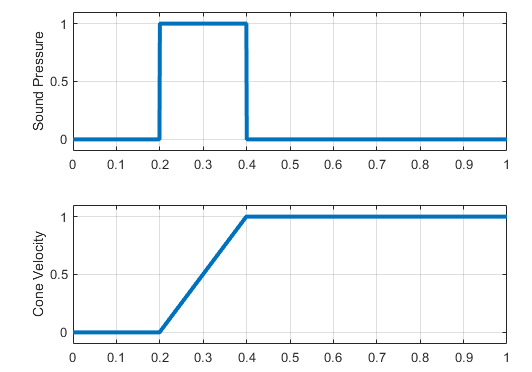Intuition can play us tricks. Take this simple example: how does a speaker cone move when you try to make it produce a “pulse”? I’m willing to bet quite a few of you will guess it will rapidly move forward and then equally rapidly return to its rest position. And from that it’d be quite reasonable to conclude that a heavy cone would be pretty bad at doing this. Quite reasonable but sadly also quite wrong.
You see, acoustics doesn’t work like that. If it did, you’d be able to produce constant pressure by moving the cone forward and keeping it there. What really happens is that the air simply gets out of the way of the cone and life goes on.
You couldn’t even produce constant pressure by keeping the cone moving at a constant speed. You’d get what we call wind, but as soon as that wind gets going, pressure settles back to normal. In short, the only way you can get pressure from a moving piston is by making it push on the air, accelerating it. Making a short pressure pulse then simply amounts to pushing (accelerating) for a very short time.
That just shows you how fallible our intuition is. Sound pressure doesn’t correspond to cone position. Not even to cone velocity. It corresponds to acceleration. So now we can answer the question: what movement does a cone make when you ask it to put out an acoustic pulse? It accelerates during the pulse and then keeps coasting:(Wait, isn’t the amplifier supposed to stop cone movement? Eventually, yes, but not nearly as fast as the damping factor myth would have it. We’ll devote another blog post to that.)
Basically, what we’re saying is that fundamentally, moving mass only affects sensitivity, while what folks call “fast” or “slow” amounts to bandwidth. And that does not relate to mass, but mostly to how real cones flex and spring back when you push on them. How much depends on material type and geometry but not directly on mass. A case in point: diamond tweeter domes are fabled for their “speed”, i.e. bandwidth, but as it happens, they are also the heaviest domes in regular use. This is reflected in diamond tweeters’ lower than average efficiency. But even though diamond domes are much heavier than their aluminum counterparts, they’re much, much stiffer too.
There’s little point in elaborating the intricacies of membrane design here because you can simply look at the frequency response graph. If a driver’s response is smooth and continues a long way, it’s ‘fast’.
